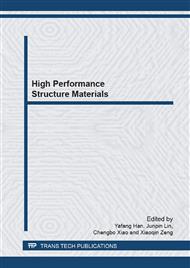p.124
p.132
p.139
p.146
p.152
p.158
p.166
p.172
p.178
Experimental Research on the Friction and Wear Properties of Ni-Based Composite Coating Prepared by Laser Cladding
Abstract:
In this study, the dry sliding wear behavior of Ni-based self-lubricating wear-resistant coating was characterized under various loads at 300 . Morphologies and compositions of the worn surface were analyzed by scanning electron microscopy (SEM) and energy dispersive spectroscopy (EDS). The experimental results showed that with the increase of load, both the frictional coefficient and wear rate decreased firstly, then slightly increased. A small amount of debris dispersed on the worn surface of the coating under low load (2 N). Since the effects of oxide layer and lubricant particles spreading onto the worn surface, the coating exhibited superior friction, and improved the wear properties under moderate load (5 N). As the load further increased, till up to 10N, the worn surface started to appear some shallow grooves and craters. This was contributed to the dispersion of carbides and lubricant particles.
Info:
Periodical:
Pages:
152-157
Citation:
Online since:
February 2013
Authors:
Price:
Сopyright:
© 2013 Trans Tech Publications Ltd. All Rights Reserved
Share:
Citation:


